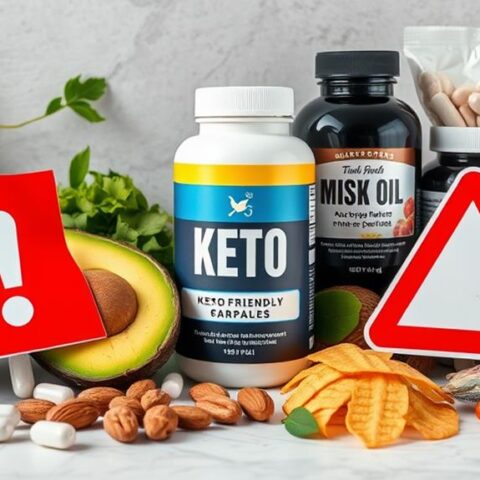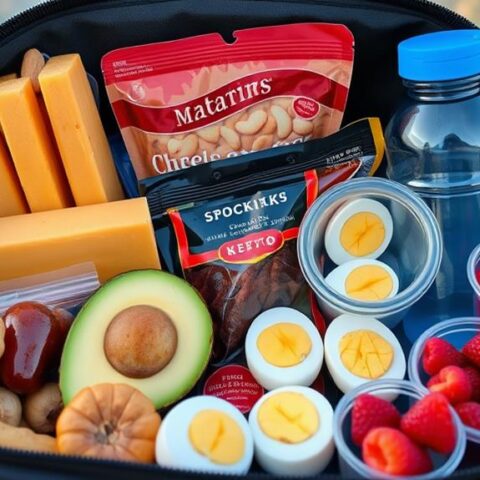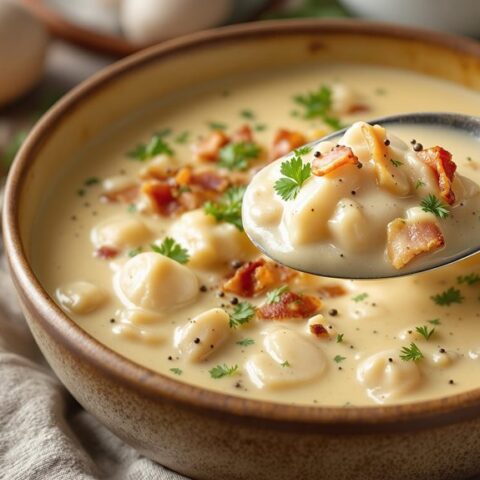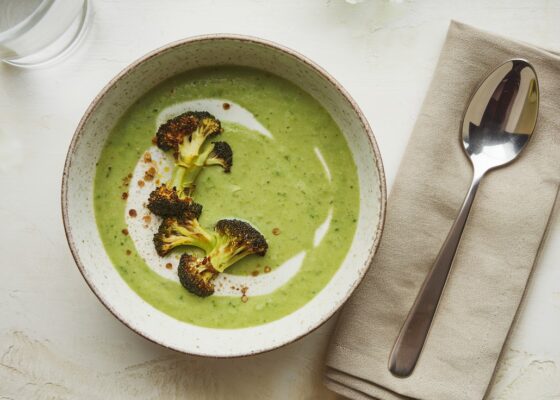
Ranch dressing can be low-carb when carefully selected, typically containing 1-3 grams of carbohydrates per two-tablespoon serving. Store-bought varieties vary markedly, with some brands adding hidden sugars that increase the carb content. Homemade versions offer better control over ingredients and usually contain fewer carbs. Checking nutrition labels remains essential, as light or reduced-fat versions often contain more carbohydrates. Understanding the specific ingredients helps maintain ketosis while enjoying this popular condiment.
Key Takeaways
- Store-bought ranch typically contains 1-3 grams of carbs per 2-tablespoon serving, making it generally suitable for low-carb diets.
- Commercial ranch dressings may contain hidden sugars and starches, so carefully reading ingredient labels is essential.
- Homemade ranch dressing offers better carb control, usually containing only 1-2 grams of carbs per serving.
- Light or reduced-fat versions often have higher carb content, up to 5 grams per serving.
- The base ingredients of ranch (mayonnaise, sour cream, herbs) are naturally low in carbohydrates.
Understanding Carbs in Store-Bought Ranch Dressing
While many people following low-carb diets worry about their condiment choices, store-bought ranch dressing typically contains a moderate amount of carbohydrates that can fit into most low-carb eating plans.
Most store-bought ranch dressing contains between 1 to 3 grams of total carbs per serving, with Hidden Valley Ranch offering approximately 2 grams per 2-tablespoon portion.
However, consumers should carefully review the nutrition label, as manufacturers often include added sugars or high fructose corn syrup that can increase the carbohydrate content.
Light or reduced-calorie versions may actually contain higher carb counts, sometimes up to 5 grams per serving, due to additional thickeners and sugar substitutes.
These variations in carbohydrate content make it essential to compare different brands and formulations when selecting a ranch dressing that aligns with specific dietary goals.
Also, it's crucial to differentiate between total and net carbohydrates to ensure you're not exceeding your daily carb limits, especially when maintaining ketosis on a low-carb diet.
Making Your Own Low-Carb Ranch Dressing
Making homemade ranch dressing offers flexibility in choosing between fresh herbs, which provide vibrant flavors, or dried herbs that offer convenience and longer shelf life. The assembly process becomes effortless when all ingredients are measured beforehand and combined in a single bowl, with herbs being added gradually to achieve the desired taste intensity. Fresh herbs like parsley, dill, and chives can be finely chopped and incorporated immediately, while dried herbs benefit from a brief resting period to allow their flavors to fully develop in the creamy base. For those on a ketogenic diet, consider using keto-friendly sweeteners like stevia or erythritol to add a hint of sweetness without disrupting ketosis.
Fresh Vs Dried Herbs
When creating homemade low-carb ranch dressing, the choice between fresh and dried herbs can greatly impact the final flavor profile. Fresh herbs provide a more vibrant and robust taste, with recipes typically calling for three times the amount compared to their dried counterparts. For ideal results, one tablespoon of fresh herbs equals one teaspoon of dried herbs in a low-carb ranch dressing recipe.
While fresh herbs deliver superior flavor, dried herbs offer practical advantages, including extended shelf life and convenience. When using dried herbs, checking expiration dates guarantees maximum potency and taste.
Both options maintain the low-carb integrity of homemade ranch dressing, containing approximately 1g of total carbs and 0.9g of net carbs per serving, making either choice suitable for a low-carb lifestyle.
Quick Assembly Tips
The assembly of homemade low-carb ranch dressing follows a straightforward process that builds upon the proper selection of herbs.
The quick and easy preparation begins by combining avocado oil-based mayonnaise with sour cream or Greek yogurt to create a creamy foundation. Next, blend in lemon juice or vinegar for tanginess, followed by unsweetened almond milk to achieve the desired consistency.
The ingredients together form a classic ranch flavor profile when seasoned with dried herbs like parsley, dill, and chives, along with garlic powder, onion powder, sea salt, and black pepper.
For best results, store the homemade dressing in an airtight container and refrigerate for at least one hour before serving, allowing the flavors to fully develop. This low-carb version remains fresh for up to ten days when properly stored.
Essential Ingredients for Keto-Friendly Ranch
Since crafting a successful keto-friendly ranch dressing relies on carefully selected ingredients, understanding the essential components becomes crucial for maintaining ketosis while enjoying this popular condiment.
The foundation of any keto ranch dressing recipe starts with mayonnaise and sour cream, which provide the creamy base while contributing minimal carbohydrates. Greek yogurt serves as an excellent alternative to sour cream, offering added protein without compromising the low-carb profile.
To achieve the perfect consistency, unsweetened almond milk can be incorporated as a carb-conscious thinning agent. Fresh or dried herbs, including dill, parsley, and chives, complete the classic ranch flavor profile while keeping carbohydrates at approximately 1g per serving, making this dressing an ideal choice for those following low carb recipes.
Additionally, incorporating high-fat dairy such as whipping cream can enhance the richness and flavor of the dressing while staying in line with keto dietary requirements.
Fresh vs. Dried Herbs: Impact on Carb Content
The choice between fresh and dried herbs in ranch dressing has minimal impact on carbohydrate content, as both forms contribute less than one gram of carbs per serving.
When measuring herbs for ranch dressing, following the 3:1 ratio of fresh to dried herbs guarantees proper flavor balance while maintaining negligible carb counts.
Fresh herbs offer vibrant flavors and higher nutrient content initially, while dried herbs provide extended shelf life and concentrated flavors over time, making both options suitable for low-carb ranch dressing preparation.
Herb Freshness Affects Carbs
Choosing between fresh and dried herbs for ranch dressing involves understanding their distinct carbohydrate profiles, which can impact the overall carb content of the final product.
While herb freshness considerably affects carb levels, both fresh and dried herbs remain suitable for low-carb ranch dressing preparations.
- Fresh herbs contain minimal carbohydrates (approximately 0.1g per tablespoon), making them perfect for strict low-carb diets.
- Dried herbs have slightly higher carb content (about 1g per tablespoon) due to concentration, but still maintain low-carb status.
- Using the recommended 1:3 ratio when substituting dried herbs for fresh guarantees ideal flavor while keeping carbohydrates minimal.
The marginal difference in carb content between fresh and dried herbs means both options can be confidently used in ranch dressing without compromising its low-carb status.
Storage Impact On Nutrients
Understanding storage conditions reveals significant differences in how fresh and dried herbs maintain their carbohydrate content and nutritional value over time in ranch dressing preparations.
When stored properly, dried herbs demonstrate superior nutrient retention and maintain consistent carbohydrate levels longer than their fresh counterparts, despite having slightly higher initial carb content.
Fresh herbs in ranch dressing may offer superior nutritional benefits immediately after preparation, but their nutrients degrade more rapidly during storage. This degradation process can eventually lead to comparable carbohydrate content between fresh and dried herb versions.
While dried herbs require less volume for flavoring and have longer shelf stability, they may contain additional carbohydrates from processing methods. The storage impact on nutrients ultimately affects both the carbohydrate profile and overall nutritional value of ranch dressing preparations.
Measuring Fresh Versus Dried
Measuring herb quantities accurately becomes a key factor in managing carbohydrate content when preparing ranch dressing.
When comparing fresh herbs to dried herbs in low-carb diets, understanding their concentration differences is essential for maintaining desired carb levels. Fresh herbs generally contain fewer carbohydrates per volume, making them an excellent choice for carb-conscious individuals.
- Fresh herbs contain approximately 75% fewer carbs than their dried counterparts per tablespoon.
- The standard substitution ratio is 1 tablespoon fresh to 1 teaspoon dried herbs.
- Both variations contribute minimal carbs to ranch dressing, typically less than 1 gram per serving.
While both fresh and dried herbs can be used in ranch dressing recipes, careful measurement guarantees accurate tracking of carb content, particularly when following strict low-carb dietary guidelines.
Best Mayo Options for Low-Carb Ranch
To create a successful low-carb ranch dressing, the selection of mayonnaise serves as a critical foundation. The ideal mayo options include those made with avocado oil or olive oil, which provide healthier fats while maintaining minimal carbohydrate content. When selecting store-bought mayo for low-carb ranch dressing, carefully examine labels for no added sugars and verify that total carbohydrates remain at 0-1g per tablespoon. Homestyle options like homemade mayonnaise offer complete control over ingredients, making it an excellent choice for those following strict low-carb diets. For those seeking alternatives, vegan mayo can also work well in low-carb ranch recipes, provided it meets the necessary carbohydrate requirements. Regardless of the chosen option, prioritize products without seed oils or hidden sweeteners to maintain the integrity of your low-carb ranch dressing. For instance, olive oil is rich in monounsaturated fats and antioxidants, promoting cardiovascular health and enhancing the nutritional quality of your dressing.
Dairy Alternatives That Keep Carbs Down
When creating low-carb ranch dressing, plant-based milk alternatives like almond milk and coconut milk offer excellent options with minimal carbohydrate content, typically containing only 1-6 grams per cup. For those seeking dairy-free alternatives, vegan mayonnaise made from avocado or sunflower oil provides the necessary creamy base while maintaining low carb counts. Greek yogurt serves as an effective substitute for traditional dairy ingredients, contributing beneficial protein while keeping carbohydrates in check at 6-9 grams per serving. Incorporating nuts and seeds into your diet can enhance flavor and add healthy fats while aligning with low-carb goals.
Plant-Based Milk Options
For those seeking to keep their ranch dressing low in carbohydrates, plant-based milk alternatives offer excellent solutions without sacrificing creamy texture. Several dairy alternative options provide the perfect base for a low-carb ranch dressing while keeping carbohydrate content minimal.
- Unsweetened almond milk contains just 1-2 grams of carbohydrates per cup, making it an ideal choice.
- Cashew milk offers similar benefits with only 1 gram of carbs per cup, while maintaining a rich consistency.
- Coconut milk provides a creamy texture with 2-3 grams of carbs per cup, perfect for ranch dressing.
When selecting plant-based milk options for ranch dressing, choosing unsweetened varieties is vital to avoid unnecessary carbohydrates.
These alternatives enable the creation of delicious ranch dressing while maintaining a low-carb profile suitable for various dietary needs.
Yogurt Without Dairy Works
Dairy-free yogurt alternatives have revolutionized the way health-conscious individuals prepare their ranch dressing while maintaining minimal carbohydrate content.
These low carb options, including Greek yogurt and dairy-free yogurt made from almonds, coconut, or soy, typically contain just 1-3 grams of carbohydrates per serving.
When selecting dairy alternatives for ranch dressing recipes, it's essential to examine nutrition labels for hidden sugars that could increase the carbohydrate content.
Unsweetened almond milk, containing approximately one gram of carbs per cup, pairs exceptionally well with dairy-free yogurt bases to create creamy, low-carb dressings.
These alternatives not only maintain the desired texture and flavor profiles but also provide versatility in recipe adaptation, making them ideal for those following carbohydrate-restricted dietary patterns.
Hidden Sugar Sources in Commercial Ranch
Several hidden sugar sources lurk in commercial ranch dressings, potentially derailing low-carb dietary goals. Popular brands often incorporate added sugars through high fructose corn syrup or cane sugar, contributing 1-2 grams per serving.
Additionally, modified food starch and artificial flavorings can increase the total carbohydrate content considerably.
- Store-bought ranch dressings may contain up to 3-4 grams of total carbohydrates per serving.
- Hidden sugars appear under various names on ingredient labels, making careful label reading essential.
- Commercial ranch formulations frequently include carb-heavy preservatives and thickeners.
Regular tracking of carbohydrate intake is essential to ensure compliance with low-carb goals, especially when consuming store-bought products that may contain hidden sugars.
For those following low-carb diets, homemade ranch dressing offers the best solution, providing complete control over ingredients and eliminating unwanted sugars.
This approach guarantees compatibility with dietary requirements while maintaining the classic ranch flavor profile.
Storing Your Low-Carb Ranch Creation
While proper storage techniques greatly affect the longevity and quality of homemade low-carb ranch dressing, following specific guidelines guarantees excellent freshness and flavor retention.
For best results, store the dressing in an airtight container, preferably a mason jar, and refrigerate immediately after preparation. Allow the mixture to rest for at least one hour before serving, though a 24-hour period guarantees maximum flavor development.
The dressing maintains its peak freshness for up to 10 days when properly stored. Before each use, shake the container thoroughly to recombine any separated ingredients.
Avoid freezing the dressing, as this can compromise its texture and consistency upon thawing. Mason jars prove particularly useful for storage, offering convenient shaking and serving capabilities while maintaining freshness.
Regular monitoring of nutritional deficiencies is advised to ensure that your low-carb diet remains balanced and healthy.
Quick Tips for Reading Ranch Dressing Labels
Understanding ranch dressing labels can make the difference between choosing a genuinely low-carb option and inadvertently consuming hidden carbohydrates. When examining store-bought ranch dressings, consumers should focus on several key factors to make informed decisions about their selections.
Making smart choices with ranch dressing starts with understanding labels to avoid hidden carbs and select truly low-carb options.
- Check the total net carbs per serving, aiming for 2 grams or less to maintain a low-carb lifestyle.
- Examine the ingredients list carefully for hidden sugars and artificial preservatives that could impact both health and carbohydrate content.
- Compare serving sizes between brands, as smaller portions may mask higher carb counts.
Look for ranch dressings featuring high-quality fats like avocado or olive oil instead of processed seed oils. These healthier options often contain fewer additives while maintaining the classic ranch flavor profile. Including oils rich in monounsaturated fats, like olive oil, can be beneficial for heart health and inflammation reduction.
Serving Sizes and Carb Management
Proper portion control plays an essential role in managing carbohydrate intake when incorporating ranch dressing into a low-carb diet. The standard serving size of two tablespoons provides a practical framework for carb management, particularly when following strict dietary guidelines. When preparing homemade ranch dressing, individuals can better monitor their carb consumption while enjoying this popular condiment. Most homemade recipes contain only 1-2 grams of carbohydrates per serving, making them suitable for low-carb diets. To enhance your keto pantry staples, consider stocking up on healthy fats and oils, which can be used to create a delicious, low-carb homemade ranch dressing.
Common Ingredients to Avoid
For individuals following a low-carb diet, certain ingredients commonly found in store-bought ranch dressings can derail their nutritional goals.
While homemade ranch dressing offers better control over ingredients, commercial versions often contain hidden carbohydrates that can impact blood sugar levels and ketosis.
- Added sugars and high-fructose corn syrup are primary offenders, contributing unnecessary carbs while serving as preservatives and flavor enhancers.
- Modified food starches and thickening agents like xanthan gum increase the carbohydrate content while providing texture.
- Artificial flavors and preservatives may contain maltodextrin or other carb-based carriers.
Many low-fat products, including some ranch dressings, contain hidden sugars that disrupt ketosis, which is why reading ingredient labels is crucial.
When selecting ranch dressing, carefully examine the ingredient list for these problematic additions.
Choosing products with clean, whole-food ingredients or preparing a homemade version guarantees better alignment with low-carb dietary goals.
Thickening Ranch Without Adding Carbs
While avoiding problematic ingredients helps maintain a low-carb profile, achieving the perfect creamy consistency in ranch dressing requires specific thickening techniques that won't compromise carbohydrate counts. Several effective methods exist for thickening ranch while maintaining its low carb status, from incorporating additional dairy components to utilizing specialized ingredients.
| Method | Benefits | Application |
|---|---|---|
| Mayonnaise/Sour Cream | Adds creaminess | Blend gradually until desired thickness |
| Xanthan Gum | Zero carbs | Add small amounts while whisking |
| Parmesan Cheese | Enhances flavor | Grate finely and incorporate |
For those seeking dairy-free alternatives, blended silken tofu offers excellent thickness without carbs. Additionally, reducing liquid ingredients like almond milk can naturally concentrate the dressing's consistency while preserving its authentic ranch flavor profile.
Pairing Low-Carb Ranch With Keto Foods
Successfully incorporating ranch dressing into a ketogenic diet requires strategic food pairings that maximize flavor while maintaining strict carbohydrate limits.
Low carb ranch dressing's versatility makes it an excellent complement to numerous keto-friendly foods, enhancing meals without compromising dietary goals.
- Fresh vegetables like celery and bell peppers paired with ranch create satisfying snacks that support ketosis.
- Chicken wings and grilled meats benefit from ranch dressing as a flavorful dipping sauce or topping.
- Salad combinations, including Cobb and BLT variations, become more appealing with ranch while staying low carb.
The adaptability of ranch dressing extends beyond basic applications, working well in casseroles and buffalo-flavored dishes to maintain keto compliance while adding creamy texture and enhanced taste.
Frequently Asked Questions
Is Ranch Dressing OK for Low Carb Diet?
Ranch dressing ingredients, particularly homemade versions, align well with low-carb diets. Store-bought varieties may contain hidden sugars, but keto-friendly ranch alternatives and low-carb recipes maintain nutrition while minimizing carbohydrate content.
What Is the Best Dressing for Low Carb Diet?
Homemade vinaigrettes and keto-friendly options made with natural dressing ingredients offer the best low-carb alternatives. Oil-based dressings with herbs provide diverse flavor profiles while maintaining lower calorie comparison than store-bought varieties.
What Is the Difference Between Ranch Dressing Packets and Bottles?
Ranch dressing packets contain dried ingredients for customizable mixing, while bottles offer pre-mixed convenience. Packet nutrition typically has fewer additives, different flavor profiles, and flexible serving sizes compared to bottled dressing options.
Where Is Ranch Dressing on the Glycemic Index?
Ranch dressing ingredients place it very low on the glycemic index due to minimal carbohydrates. Among low-carb sauces, ranch alternatives offer health benefits while maintaining negligible glycemic impact compared to sugar-based dressings.
Conclusion
Ranch dressing can fit into a low-carb lifestyle with careful attention to ingredients and portion sizes. Store-bought varieties often contain hidden sugars and stabilizers that increase carb content, making homemade versions the ideal choice for carb-conscious consumers. By selecting quality ingredients like real mayonnaise, sour cream, and fresh herbs, while avoiding unnecessary additives, anyone can create a delicious, keto-friendly ranch dressing that enhances their low-carb meals.










No Comments